为什么辣是一种痛觉而非味觉
味觉(酸、甜、苦、咸、鲜)是通过作用于味觉细胞(taste cell)上的受体蛋白,激活味觉细胞以及相连的神经通路。而辣的感觉是通过辣椒素(capsaicin)等作用于舌头中的痛觉纤维上的受体蛋白而产生的。这条通路同时也是痛觉的传导通路。因此从神经科学的角度来说辣更类似于痛觉。不同的化学物质激活受体蛋白,使味觉细胞去极化,之后释放神经递质激活下游的神经通路,从而产生相应的味觉(氢离子-酸,葡萄糖;蔗糖、果糖等-甜;奎宁-苦;钠离子-咸;氨基酸-鲜)。
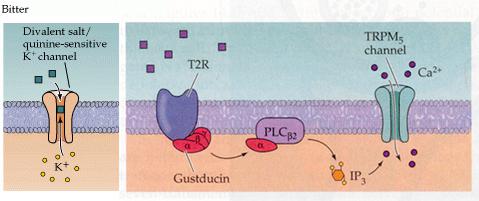
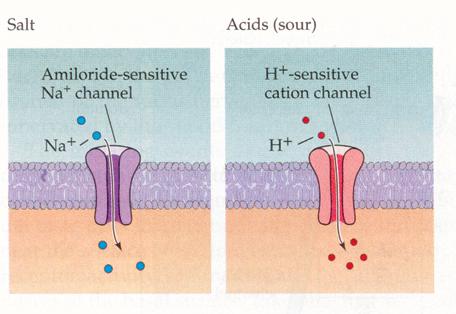
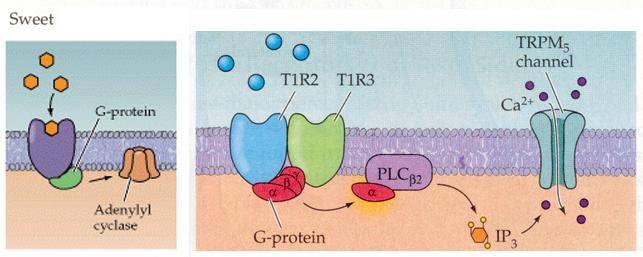
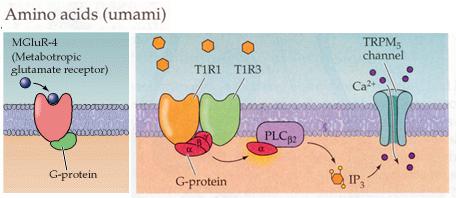
另外的一种在痛觉中起到重要作用的受体是TRPA1。TRPV1能被辣椒素等化学物质以及有害的热刺激激活;TRPA1能被芥末等化学物质以及有害的冷刺激激活。(此处的激活,主要离子通道在静息状态下更容易开放。)当这些TRP通道开放时,阳离子进入细胞,细胞去极化产生动作电位进而激活痛觉神经通路。
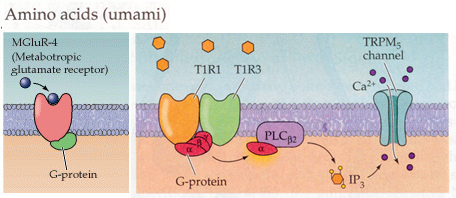
bidi-font-family:"Times New Roman";mso-font-kerning:1px;mso-ansi-language: EN-US;mso-fareast-language:ZH-CN;mso-bidi-language:AR-SA'>甜;奎宁-苦;钠离子-咸;氨基酸-鲜)。
不同的食物,产生辣味的化学物质不同,但主要是作用于TRPV1和TRPA1受体。
生姜 – ‘Gingerol, or sometimes [6]-gingerol, is the active constituent of fresh ginger. Chemically, gingerol is a relative of capsaicin and piperine, the compounds which give chilli peppers and black pepper their respective spicyness.’ 辣椒素类似物,应该是作用于TRPV1
生大蒜 – allicin,主要作用于TRPA1,也作用于TRPV1
芥末,山葵,小萝卜等 - Allyl isothiocyanate,作用于TRPA1
三.引用from neuron to brain的原文来回答辣是味觉还是痛觉的问题:主要在于如何定义味觉。
‘It is important to note that taste, as a percept, results from sensations in addition to those reported by the taste buds. The aroma detected by olfaction, as well as by texture and temperature, which are sensed by somatosensory neurons, all contribute to the ultimate identification and appreciation of food. The hot taste of chili peppers particularly reinforces this concept. Hot chilies are not sensed by taste cells per se, but rather by pain fibers in the tongue that are activated by the compound capsaicin. A capsaicin receptor has been cloned and shown to be a calcium-selective cation channel. The hot receptor, known as transient receptor potential (subfamily V, member 1), or TRP-V1, is also found in small diameter sensory fibers (C fibers) responding to noxious temperatures (see following section). Thus, nature has provided chili peppers with a chemical targeted to this receptor, possibly to discourage herbivores by activating pain fibers - a not entirely successful strategy in the case of humans with a preference for spicy foods.’
(From neuron to brain, fifth edition p.p. 402-403)
结论:
辣和痛觉的神经通路一致,而与酸、甜、苦、咸、鲜等味觉神经传导通路不同。
不同的辣味由不同的化学物质引起,但其激活的受体蛋白大致相同。
参考文献:
From neuron to brain (fifth edition) by John G. Nicholls, A. Robert Martin, Paul A. Fuchs, David A. Brown, Mathew E. Diamond, David Weisblat p.p. 402-403
Macpherson, Lindsey J, Bernhard H Geierstanger, Veena Viswanath, Michael Bandell, Samer R Eid, SunWook Hwang, and Ardem Patapoutian. “The Pungency of Garlic: Activation of TRPA1 and TRPV1 in Response to Allicin.” Current Biology : CB 15, no. 10 (May 24, 2005): 929–34. doi:10.1016/j.cub.2005.04.018.
Ferrandiz-Huertas, Clotilde, Sakthikumar Mathivanan, Christoph Jakob Wolf, Isabel Devesa, and Antonio Ferrer-Montiel. “Trafficking of ThermoTRP Channels.” Membranes 4, no. 3 (January 19, 2014): 525–64. doi:10.3390/membranes4030525.
四. 作者:Millie M
五. 链接:https://www.zhihu.com/question/20615762/answer/44462433
六. 来源:知乎



